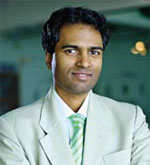Of the two approaches to using treated sewage effluent (TSE), the direct use of raw TSE comes with a lower capital cost, higher water usage, higher chemical usage and, always worryingly, a higher microbiological risk.

B Surendar
Of the two approaches to using treated sewage effluent (TSE), the direct use of raw TSE comes with a lower capital cost, higher water usage, higher chemical usage and, always worryingly, a higher microbiological risk. The TSE polishing method, on the other hand, comes with a higher capital cost, lower use of chemicals and water and a lower microbiological risk.
Typically, re-circulation of raw TSE in a cooling tower in a district cooling scheme involves such parameter as salinity, TDS, chloride and sulphate for consideration. Potable water is, of course, king, because largely speaking, these parameters are not factors. Thus, it is the case that while potable water allows five to six cycles of concentration, raw TSE allows 2.5 to three cycles.
Government regulation in Abu Dhabi and Dubai having taken potable out of the picture – and not to forget, the high costs involved, in the first place, anyway – the toss-up is between raw and polished (with seawater cooling as a possible option in coastal developments). In the new paradigm, recent technological developments in wastewater treatment plants allow for an improvement in quality of raw TSE. Polishing takes the water several notches higher. Though polished TSE comes at a cost higher than raw TSE, the fact of the matter is that it allows for higher cycles of concentration – sometimes, higher than even potable water.
Cost is too important a factor to ignore, though. It always has been and is more so in this period of economic uncertainty, in a world that is increasingly talking of a double-dip recession. At such times – and other times, as well – thinking beyond the conventional helps. Condensate water recovery is unconventional. Though it has been used for many, many years, it has never been viewed as a significant factor in district cooling plants. That view surely has to change in these times. At Reem Island, they are collecting condensate water with the intention of making their district cooling plants more water efficient. Nearly 20% of the make-up water will come from condensate water that is collected from buildings in the development. And for this, they say, considerable investment has gone into installing buffer tanks, pumps and pipes throughout the reticulation network.
Considering the fact that condensate water is very high quality water, when blended with TSE, it will improve the quality of TSE. The folks at Reem Island say that when they consider condensate water recovery and the use of polished water as benchmarks, the overall water efficiency of their district cooling plants is high.
Indeed, why let it drip and drain away, then?
B Surendar
Copyright © 2006-2025 - CPI Industry. All rights reserved.